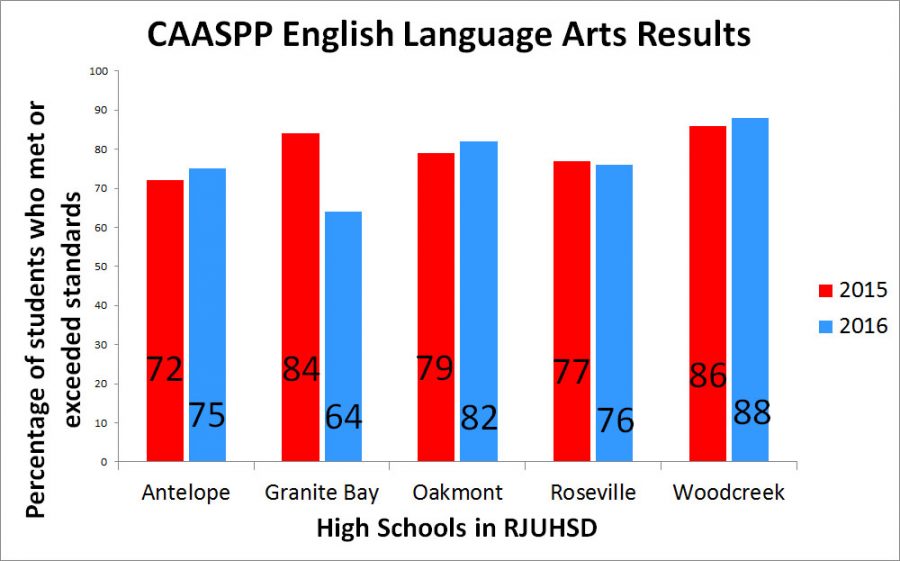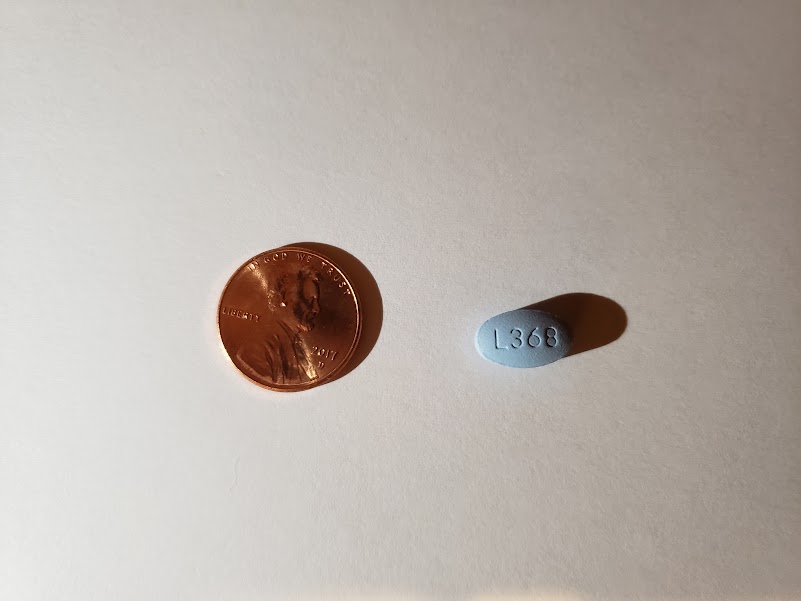Granite Bay High School is known for its high achieving students and for ranking at the top of many lists, whether it be in athletics, arts or academics.
This year, however, GBHS is ranked just above Center High School as 26th in the Sacramento region by English Language Arts test scores.
Every March, Californian students in grades three through eight and grade 11 take the Smarter Balanced Assessment Consortium (SBAC) test from the California Assessment of Student Performance and Progress (CAASPP) program, in order to calculate school rankings.
The CAASPP program replaced the Standardized Testing and Reporting (STAR) program in 2013. The 2015 administration of the test was the “pilot” test that established the baseline scores for the school, according to GBHS principal Jennifer Leighton.
GBHS had a 17 percent drop in students exceeding or meeting the standards in the English Language Arts section from 2015 to 2016.
“We’re used to looking at ourselves up at the top (of a list) and you have to go all the way down to find us,” Leighton said.
There have been many questions as to why such a significant drop is apparent when Advanced Placement, International Baccalaureate, SAT and ACT scores still remain at their traditional height.
Possible answers include that the poor performance is a silent rebellion against the common core system, lack of pride for the school, and the test not “counting” directly for the students like it counts for the school.
The overarching reason, however, seems to be that the students were uniformed about the effects of the test.
“I wasn’t told anything about the effects of taking the test, just that it was mandatory and for the state,” an anonymous senior boy said. “I gave zero effort on the test because I didn’t know the importance of the test to our school.”
While others may have given more effort, most didn’t know what the purpose of the CAASPP was.
“My teachers had said that it didn’t count toward my grades and the only people who would see it were from the state, so I had no inclination to take it,” senior Gemma Rizzuto said.
Student Effects
The CAASPP test does have potential benefits for students who score well.
“If you do well on this test, then you don’t have to take an assessment test (if you go to a California community college or a California State University),” Leighton said. “You are college ready so you won’t end up in a really low-level English or math class.”
Furthermore, the school’s performance is noted on the Common Application, the application that several seniors will be using this fall to apply to several colleges.
“A lot of our students didn’t feel like it would directly affect them,” Leighton said. “Indirectly it does come back. It will be reflected on the college profile that is uploaded onto the Common App. So normally Granite Bay has this great reputation for test scores but the English scores aren’t going to look very good.”
Opting out of the test
Before the test was even administrated, many students like Rizzuto had little motivation to take the test. Many decided to exercise their right to opt-out of the state test.
California Education Code 60615 allows parents to submit a written request to their child’s school which exempts their child from taking any part of administered assessments.
Section 852 of Title 5 of the California Code of Regulations further reiterates that a parent or guardian can “annually submit to the school a written request to excuse his or her child from any or all parts of any test provided pursuant to Education Code section 60640 for the school year.”
During the spring of 2016, nearly five percent of current seniors opted out of the CAASPP test.
By federal law, 95 percent of students must take a given test for the results of that test to be valid.
“We had a lot of kids walk in with like a post-it note, written quickly,” Leighton said. “So we sent them back and said we need an official note from a parent stating why you’re opting out of this.”
Those who did turn in a formal letter, however, received a letter back from the school at a later date.
This letter stated that should the student not make up the test on the given date, they may not receive a letter of recommendation because GBHS staff considers if a student has contributed “to the development of GBHS.”
“The school decided to punish those who decided to opt out,” Rizzuto said. “There was a letter I received that said that the school would not write any recommendation letters I needed to get into college if I didn’t take the test. Anyone who cares to get into a good college was basically then forced to take it, when legally there are supposed to be no consequences.”
According to Edsource, if a school fails to test 95 percent of its junior class, they will be labeled as “failing to make Adequate Yearly Progress” and could face additional repercussions.
Gunn High School, in Palo Alto, CA, reported that nearly half of its students opted out, many to devote their time to study for the SAT or AP exams.
Leighton said that many of the students she talked to with high GPAs and low CAASPP results felt similarly to the students from Palo Alto.
“A lot of our students felt really stressed out,” Leighton said. “They wanted to hurry and finish the test so they could study for their AP and IB (tests) or their SAT.”
Senior Chloe Miller missed two of the test dates and was told to make it up on a Wednesday morning and was frustrated by the process.
“The testing procedure was very unorganized and the cart of chromebooks took forever to get to us and (it) took forever to get supplies out and then we weren’t allowed to leave when we were done,” Miller said.
School Effects
“The purpose is really to give feedback to us and the state on what kind of education we’re giving to our students,” Leighton said.
The low ELA scores are likely to impact not solely the school’s ranking, but also the Local Control and Accountability Plan, the school’s Western Association of Schools and Colleges (WASC) accreditation and eligibility for the National Blue Ribbon award.
Leighton said the district used to distribute money to each school and say how much was to go to a specific category.
“But now they’ve given us a sum of money and said as long as you justify where you are using it and how, you can get what you need,” Leighton said. “So it makes it look like we’re misusing our money.”
Secondly, GBHS’s WASC accreditation could be in danger. WASC is an organization that releases a report every six years and “decide(s) whether you are doing a good job as a school.”
Leighton said that the last time WASC visited the school, there were areas of concern. The mid-cycle visit is in January.
“They will be looking at our scores,” Leighton said. “We will have to say ‘Actually we are doing a really good job, we are a really great school. That was kind of just a weird thing that happened so don’t worry about it.’ It just makes us look a little silly because we do so well in our AP and IB tests and we are barely above state average in our English scores.”
The third large effect of the CAASPP is Granite Bay High’s National Blue Ribbon.
The National Blue Ribbon is a prestigious award and is a “widely recognized symbol of exemplary teaching and learning.”
“It makes us look great, it helps our home values, it just makes it so people want to come to Granite Bay High School,” Leighton said. “It’s just another icing on the cake.”
A school must be invited to even apply for a National Blue Ribbon and the invitation doesn’t usually come very often.
“The last time I heard of us applying was in 2002 and we got it,” Leighton said. “And then it came across my desk this year and (we went) for it.”
The lengthy application was due in the spring.
“At the end of the year we found out (we would) get the award … pending (our) scores on the CAASPP,” Leighton said. “I wasn’t worried. I really wasn’t worried because we’ve never had a problem before with STAR test scores or CAASPP scores or anything.”
A few weeks ago Leighton got a call saying that GBHS had been disqualified as a result of the low ELA scores on the CAASPP.
Improvement for the future
As far as the future goes, Leighton and the leadership team have been working to find a way to improve GBHS’ results for the next year.
They are considering placing the scores on students’ transcripts so they feel more accountable. They are also considering having some sort of incentives for students who do well on the CAASPP.
Several years ago when the STAR test was being administered, some teachers offered grade bumps for achieving advanced on the STAR test.
“I’d rather focus on ways we can improve, how we give the test and how we motivate students beforehand rather than going back to punitive measures,” Leighton said. “We need to do a better job at explaining what it can affect. It’s just a matter of we forgot to front load this.”















